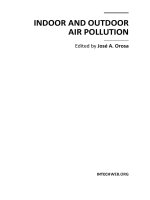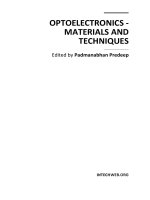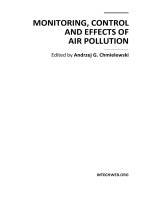Lubrication and Reliability Handbook 2010 Part 1 pptx
Bạn đang xem bản rút gọn của tài liệu. Xem và tải ngay bản đầy đủ của tài liệu tại đây (1.27 MB, 20 trang )
LUBRICATION AND RELIABILITY HANDBOOK
This Page Intentionally Left Blank
LUBRICATION AND RELIABILITY HANDBOOK
Edited by
M. J. NEALE
OBE, BSc(Eng), DIC, FCGI, WhSch, FREng, FIMechE
BOSTON OXFORD AUCKLAND JOHANNESBURG MELBOURNE NEW DELHI
Copyright © 2001 by the editor and contributors
A member of the Reed Elsevier plc group
All rights reserved.
No part of this publication may be reproduced, stored in a retrieval system, or transmitted in any form or by any
means, electronic, mechanical, photocopying, recording, or otherwise, without the prior written permission of the
publisher.
Recognizing the importance of preserving what has been written, Butterworth-Heinemann prints its books on
acid-free paper whenever possible.
Butterworth-Heinemann supports the efforts of American Forests and the Global ReLeaf program in its campaign
for the betterment of trees, forests, and our environment.
Library of Congress Cataloging in Publication Data
Lubrication and reliability handbook/edited by M.J. Neale.
p. cm.
ISBN 0 7506 5154 7
1. Lubrication and lubricants – Handbooks, manuals, etc. 2. Reliability
(Engineering) – Handbooks, manual, etc. I Neale, M. J. (Michael John)
TJ1075.L812 2000
621.8'9–dc21 00–049378
British Library Cataloguing in Publication Data
A catalogue record for this book is available from the British Library
The publisher offers special discounts on bulk orders of this book.
For information, please contact:
Manager of Special Sales
Butterworth-Heinemann
225 Wildwood Avenue
Woburn, MA 01801-2041
Tel: 781-904-2500
Fax: 781-904-2620
For information on all Butterworth-Heinemann publications available, contact our World Wide Web home page at:
10987654321
Composition by Genesis Typesetting, Rochester, Kent, England
Printed in the United States of America
CONTENTS
Introduction
List of Contributors
Lubricants
A1 Selection of lubricant type
A2 Mineral oils
A3 Synthetic oils
A4 Greases
A5 Solid lubricants and coatings
A6 Other liquids
Lubrication of components
A7 Plain bearings
A8 Rolling bearings
A9 Gears and roller chains
A10 Wire ropes
A11 Flexible couplings
A12 Slides
A13 Lubricant selection
Lubrication systems
A14 Selection of lubrication systems
A15 Total loss grease systems
A16 Total loss oil and fluid grease systems
A17 Mist systems
A18 Dip, splash systems
A19 Circulation systems
A20 Design of oil tanks
A21 Oil pumps
A22 Filters and centrifuges
A23 Heaters and coolers
A24 A guide to piping design
A25 Warning and protection devices
Machine operation
A26 Commissioning lubrication systems
A27 Running-in procedures
A28 Industrial plant environmental data
A29 High pressure and vacuum
A30 High and low temperatures
A31 Chemical effects
Machine maintenance
B1 Maintenance methods
B2 Condition monitoring
B3 Operating temperature limits
B4 Vibration analysis
B5 Wear debris analysis
B6 Lubricant change periods and tests
B7 Lubricant biological deterioration
B8 Component performance analysis
B9 Allowable wear limits
Component failures
B10 Failure patterns and analysis
B11 Plain bearings
B12 Rolling bearings
B13 Gears
B14 Pistons and rings
B15 Seals
B16 Brakes and clutches
B17 Wire ropes
B18 Fretting of surfaces
B19 Wear mechanisms
Component repair
B20 Repair of worn surfaces
B21 Wear resistant materials
B22 Repair of plain bearings
B23 Repair of friction surfaces
Reference data
C1 Viscosity of lubricants
C2 Surface hardness
C3 Surface finish and shape
C4 Shape tolerances of components
C5 SI units and conversion factors
Index
This Page Intentionally Left Blank
INTRODUCTION
This handbook is intended to help engineers in industry
with the operation and maintenance of machinery. It
gives the information that these engineers need in a
form that is instantly accessible and easy to read.
The manufacturers of machinery provide guidance on
the operation, lubrication and maintenance required for
their particular machines. However, there are, of course,
many different machines in an industrial plant or service
organisation, supplied by various manufacturers, and
there is a need to select as many similar lubricants as
possible, and to use related maintenance techniques.
This book attempts to bridge the gap which exists
between the available data on the various machines, by
providing overall guidance on how to co-ordinate the
recommendations of the various manufacturers.
The handbook is structured in a number of sections to
make it easier to use, and to bring together related
subjects, so that the reader when focusing on a particular
problem can also refer to related material that is likely to
be of interest. The various sections are listed here in this
introduction, to provide some overall guidance, addi-
tional to that available in the contents list and the
index.
Lubricants
This section describes the various types of lubricant that
are available with guidance on their overall properties
and performance. Detailed information is provided on
mineral oils, synthetic oils, greases and solid lubricants,
as well as on the various oil additives that are commonly
used. Since some machines are now lubricated by their
own process fluids information is also given on the
viscosity of water, refrigerants and various hydrocarbons
and chemicals.
Lubrication of components
The lubrication of machines relates to the lubrication of
their various moving components. This section gives
guidance on the selection of lubricants to match the
needs of the components under a range of operating
conditions. The components covered are plain and
rolling bearings, gears, roller chains, wire ropes, flexible
couplings and slides.
Lubrication systems
The next subject requiring review is the optimum
method of feeding the lubricant to the various machines
and their components. This can range from manual
greasing to automated centralising greasing systems, and
from splash, wick and ring oil feeding to pressurised mist
systems and full size oil circulation systems. Detailed
guidance is also given on the selection and design of
circulation system components such as oil tanks, pumps,
filters and coolers as well as the interconnecting piping
systems and the necessary instrumentation and warning
devices.
Machine operation
The machine manufacturers and/or process designers
will usually provide the necessary guidance on machine
operating conditions. The operating engineers can
however benefit from additional guidance on running in
procedures, and on lubricant related operating prob-
lems, such as potential lubricant deterioration due to
high or low temperatures, and the effect of contaminant
process gases and liquids. Information is provided on
these areas, together with data on fire or health hazards
from lubricants.
Machine maintenance
To keep the machines in a plant or fleet operating
effectively, requires good maintenance procedures. The
handbook reviews the suitability of the various main-
tenance methods for various types of machines and gives
guidance on their selection. Condition based main-
tenance is covered in detail with the various methods by
which the condition of a machine can be monitored
while it is in operation, so that future essential main-
tenance can be planned. Such methods include tem-
perature measurement, vibration analysis, wear debris
analysis, and lubricant tests, as well as methods of
assessing the operating performance of machine
components.
Component failure
When a failure does occur on one of the working
components of a machine, such as a bearing, gear, seal or
coupling, it is useful to have guidance on understanding
the causes of the failure from the appearance of the
failed component. This section therefore includes a
large number of photographs of machine components
showing the typical surface appearance associated with
the various failure modes.
Component repair
Finally, after a failure has occurred it is useful to have
guidance on how a worn surface can be rebuilt or
refaced, or how a bearing or friction surface can be
relined.
This handbook is based on experience from around
the world, over many years, of the investigation of
problems with machines of all kinds, and of dealing with
these by practical and economical solutions. It is hoped
that it will be helpful to the many engineers involved in
machine operation and maintenance of all kinds of
machinery and plant.
This Page Intentionally Left Blank
CONTRIBUTORS
Section Author
Selection of lubricant type A. R. Lansdown MSc, PhD, FRIC, FInstPet
Mineral oils T. I. Fowle BSc(Hons), ACGI, CEng, FIMechE
Synthetic oils A. R. Lansdown MSc, PhD, FRIC, FInstPet
Greases N. Robinson & A. R. Lansdown MSc, PhD, FRIC, FInstPet
Solid lubricants and coatings J. K. Lancaster PhD, DSc, FInstP
Other liquids D. T. Jamieson FRIC
Plain bearing lubrication J. C. Bell BSc, PhD
Rolling bearing lubrication E. L. Padmore CEng, MIMechE
Gear and roller chain lubrication J. Bathgate BSc, CEng, MIMechE
Wire rope lubrication D. M. Sharp
Lubrication of flexible couplings J. D. Summers-Smith BSc, PhD, CEng, FIMechE
Slide lubrication M. J. Neale OBE, BSc(Eng), DIC, FCGI, WhSch, FEng, FIMechE
Lubricant selection R. S. Burton
Selection of lubrication systems W. J. J. Crump BSc, ACGI, FInstP
Total loss grease systems P. L. Langborne BA, CEng, MIMechE
Total loss oil and fluid grease systems P. G. F. Seldon CEng, MIMechE
Mist systems R. E. Knight BSc, FCGI
Dip splash systems J. Bathgate BSc, CEng, MIMechE
Circulation systems D. R. Parkinson FInstPet
Design of oil tanks A. G. R. Thomson BSc(Eng), CEng, AFRAeS
Selection of oil pumps A. J. Twidale
Selection of filters and centrifuges R. H. Lowres CEng, MIMechE, MIProdE, MIMarE, MSAE,
MBIM
Selection of heaters and coolers J. H. Gilbertson CEng, MIMechE, AMIMarE
A guide to piping design P. D. Swales BSc, PhD, CEng, MIMechE
Selection of warning and protection devices A. J. Twidale
Commissioning lubrication systems N. R. W. Morris
Running-in procedures W. C. Pike BSc, ACGI, CEng, MIMechE
Industrial plant environmental data R. L. G. Keith BSc
High pressure and vacuum A. R. Lansdown MSc, PhD, FRIC, FInstPet
J. D. Summers-Smith BSc, PhD, CEng, FIMechE
High and low temperatures M. J. Todd MA
Chemical effects H. H. Anderson BSc(Hons), CEng, FIMechE
Maintenance methods M. J. Neale OBE, BSc(Eng), DIC, FCGI, WhSch, FEng, FIMechE
Condition monitoring M. J. Neale OBE, BSc(Eng), DIC, FCGI, WhSch, FEng, FIMechE
Operating temperature limits J. D. Summers-Smith BSc, PhD, CEng, FIMechE
Vibration analysis M. J. Neale OBE, BSc(Eng), DIC, FCGI, WhSch, FEng, FIMechE
Wear debris analysis M. H. Jones BSc(Hons), CEng, MIMechE, MInstNDT
M. J. Neale OBE, BSc(Eng), DIC, FCGI, WhSch, FEng, FIMechE
Lubricant change periods and tests J. D. Summers-Smith BSc, PhD, CEng, FIMechE
Lubricant biological deterioration E. C. Hill MSc, FInstPet
Component performance analysis M. J. Neale OBE, BSc(Eng), DIC, FCGI, WhSch, FEng, FIMechE
Allowable wear limits H. H. Heath FIMechE
CONTRIBUTORS
Section Author
Failure patterns and failure analysis J. D. Summers-Smith BSc, PhD, CEng, FIMechE
M. J. Neale OBE, BSc(Eng), DIC, FCGI, WhSch, FEng, FIMechE
Plain bearing failures P. T. Holingan BSc(Tech), FIM
Rolling bearing failures W. J. J. Crump BSc, ACGI, FInstP
Gear failures T. I. Fowle BSc(Hons), ACGI, CEng, FIMechE
H. J. Watson BSc(Eng), CEng, MIMechE
Piston and ring failures M. J. Neale OBE, BSc(Eng), DIC, FCGI, WhSch, FEng, FIMechE
Seal failures B. S. Nau BSc, PhD, ARCS, CEng, FIMechE, MemASME
Brake and clutch failures T. P. Newcombe DSc, CEng, FIMechE, FInstP
R. T. Spurr BSc, PhD
Wire rope failures S. Maw MA, CEng, MIMechE
Fretting of surfaces R. B. Waterhouse MA, PhD, FIM
Wear mechanisms K. H. R. Wright PhD, FInstP
Repair of worn surfaces G. R. Bell BSc, ARSM, CEng, FIM, FWeldI, FRIC
Wear resistant materials H. Hocke CEng, MIMechE, FIPlantE, MIMH, FIL
M. Bartle CEng, MIM, DipIM, MIIM, AMWeldI
Repair of plain bearings P. T. Holligan BSc(Tech), FIM
Repair of friction surfaces T. P. Newcomb DSc, CEng, FIMechE, FInstP
R. T. Spurr BSc, PhD
Viscosity of lubricants H. Naylor BSc, PhD, CEng, FIMechE
Surface hardness M. J. Neale OBE, BSc(Eng), DIC, FCGI, WhSch, FEng, FIMechE
Surface finish and shape R. E. Reason DSc, ARCS, FRS
Shape tolerances of components J. J. Crabtree BSc(Tech)Hons
S.I. units and conversion factors M. J. Neale OBE, BSc(Eng), DIC, FCGI, WhSch, FEng, FIMechE
A1Selection of lubricant type
A1.1
Table 1.1 Importance of lubricant properties in relation to bearing type
Figure 1.1 Speed/load limitations for different types of lubricant
A1 Selection of lubricant type
A1.2
Figure 1.2 Temperature limits for mineral oils
Figure 1.3 Temperature limits for some synthetic oils
A1Selection of lubricant type
A1.3
Figure 1.4 Temperature limits for greases. In many
cases the grease life will be controlled by volatility or
migration. This cannot be depicted simply, as it varies
with pressure and the degree of ventilation, but in
general the limits may be slightly below the oxidation
limits
Figure 1.5 Viscosity/temperature characteristics of
various oils Figure 1.6 Variation of viscosity with shear rate
The effective viscosity of a lubricant in a bearing may be
different from the quoted viscosity measured by a
standard test method, and the difference depends on the
shear rate in the bearing.
A2 Mineral oils
A2.1
CLASSIFICATION
Mineral oils are basically hydrocarbons, but all contain
thousands of different types of varying structure, molec-
ular weight and volatility, as well as minor but important
amounts of hydrocarbon derivatives containing one or
more of the elements nitrogen, oxygen and sulphur.
They are classified in various ways as follows.
Types of crude petroleum
Paraffinic Contains significant amounts of waxy hydro-
carbons and has ‘wax’ pour point (see
below) but little or no asphaltic matter.
Their naphthenes have long side-chains.
Naphthenic Contains asphaltic matter in least volatile
fractions, but little or no wax. Their naph-
thenes have short side-chains. Has ‘viscosity’
pour point.
Mixed base Contains both waxy and asphaltic materials.
Their naphthenes have moderate to long
sidechains. Has ‘wax’ pour point.
Viscosity index
Lubricating oils are also commonly classified by their
change in kinematic viscosity with temperature, i.e. by
their kinematic viscosity index or KVI. Formerly, KVIs
ranged between 0 and 100 only, the higher figures
representing lower degrees of viscosity change with
temperature, but nowadays oils may be obtained with
KVIs outside these limits. They are generally grouped
into high, medium and low, as in Table 2.1.
It should be noted, however, that in Table 2.5 viscosity
index has been determined from dynamic viscosities by
the method of Roelands, Blok and Vlugter,
1
since this is
a more fundamental system and allows truer comparison
between mineral oils. Except for low viscosity oils, when
DVIs are higher than KVIs, there is little difference
between KVI and DVI for mineral oils.
Traditional use
Dating from before viscosity could be measured accu-
rately, mineral oils were roughly classified into viscosity
grades by their typical uses as follows:
Spindle oils Low viscosity oils (e.g. below about
0.01 Ns/m
2
at 60°C,) suitable for the
lubrication of high-speed bearings
such as textile spindles.
Light machine oils Medium viscosity oils (e.g. 0.01–0.02
Ns/m
2
) at 60°C, suitable for machin-
ery running at moderate speeds.
Heavy machine oils Higher viscosity oils (e.g. 0.02–0.10
Ns/m
2
) at 60°C, suitable for slow-
moving machinery.
Cylinder oils Suitable for the lubrication of steam
engine cylinder; viscosities from 0.12
to 0.3 Ns/m
2
at 60°C.
Hydrocarbon types
The various hydrocarbon types are classified as follows:
(a) Chemically saturated (i.e. no double valence bonds)
straight and branched chain. (Paraffins or alkanes.)
(b) Saturated 5- and 6-membered rings with attached
side-chains of various lengths up to 20 carbon atoms
long. (Naphthenes.)
(c) As (b) but also containing 1, 2 or more 6-membered
unsaturated ring groups, i.e. containing double
valence bonds, e.g. mono-aromatics, di-aromatics,
polynuclear aromatics, respectively.
A typical paraffinic lubricating oil may have these
hydrocarbon types in the proportions given in Table 2.2.
The VI of the saturates has a predominant influence on
the VI of the oil. In paraffinic oils the VI of the saturates
may be 105–120 and 60–80 in naphthenic oils.
Table 2.1 Classification by viscosity index
Table 2.2 Hydrocarbon types in Venezuelan 95 VI
solvent extracted and dewaxed distillate
A2Mineral oils
A2.2
Structural group analyses
This is a useful way of accurately characterising mineral
oils and of obtaining a general picture of their structure
which is particularly relevant to physical properties, e.g.
increase of viscosity with pressure. From certain other
physical properties the statistical distribution of carbon
atoms in aromatic groups (% C
A
), in naphthenic groups
(% C
N
), in paraffinic groups (% C
P
), and the total
number (R
T
) of naphthenic and aromatic rings (R
N
and
R
A
) joined together. Table 2.3 presents examples on a
number of typical oils.
REFINING
Distillation
Lubricants are produced from crude petroleum by
distillation according to the outline scheme given in
Figure 2.1.
The second distillation is carried out under vacuum to
avoid subjecting the oil to temperatures over about 370°C,
which would rapidly crack the oil.
The vacuum residues of naphthenic crudes are bitu-
mens. These are not usually classified as lubricants but are
used as such on some plain bearings subject to high
temperatures and as blending components in oils and
greases to form very viscous lubricants for open gears, etc.
Refining processes
The distillates and residues are used to a minor extent as
such, but generally they are treated or refined both before
and after vacuum distillation to fit them for the more
stringent requirements. The principal processes listed in
Table 2.4 are selected to suit the type of crude oil and the
properties required.
Elimination of aromatics increases the VI of an oil. A
lightly refined naphthenic oil may be LVI but MVI if
highly refined. Similarly a lightly refined mixed-base oil
may be MVI but HVI if highly refined. Elimination of
aromatics also reduces nitrogen, oxygen and sulphur
contents.
The distillates and residues may be used alone or
blended together. Additionally, minor amounts of fatty
oils or of special oil-soluble chemicals (additives) are
blended in to form additive engine oils, cutting oils, gear
oils, hydraulic oils, turbine oils, and so on, with superior
properties to plain oils, as discussed below. The tolerance
in blend viscosity for commercial branded oils is typically
±4% but official standards usually have wider limits, e.g.
±10% for ISO 3448.
PHYSICAL PROPERTIES
Viscosity-temperature
Figure 2.4 illustrates the variation of viscosity with
temperature for a series of oils with kinematic viscosity
Table 2.3 Typical structural group analyses (courtesy: Institution of Mechanical Engineers)
Figure 2.1 (courtesy: Institution of Mechanical
Engineers)
A2 Mineral oils
A2.3
index of 95 (dynamic viscosity index 93). Figure 2.2
shows the difference between 150 Grade ISO 3448 oils
with KVIs of 0 and 95.
Viscosity-pressure
The viscosity of oils increases significantly under pres-
sure. Naphthenic oils are more affected than paraffinic
but, very roughly, both double their viscosity for every
35 MN/m
2
increase of pressure. Figure 2.3 gives an
impression of the variation in viscosity of an SAE 20 W
ISO 3448 or medium machine oil, HVI type, with both
temperature and pressure.
In elastohydrodynamic (ehl) formulae it is usually
assumed that the viscosity increases exponentially with
pressure. Though in fact considerable deviations from an
exponential increase may occur at high pressures, the
assumption is valid up to pressures which control ehl
behaviour, i.e. about 35 MN/m
2
. Typical pressure vis-
cosity coefficients are given in Table 2.5, together with
other physical properties.
Pour point
De-waxed paraffinic oils still contain 1% or so of waxy
hydrocarbons, whereas naphthenic oils only have traces
of them. At about 0°C, according to the degree of
dewaxing, the waxes in paraffinic oils crystallise out of
solution and at about –10°C the crystals grow to the
extent that the remaining oil can no longer flow. This
temperature, or close to it, when determined under
specified conditions is known as the pour point. Naph-
thenic oils, in contrast, simply become so viscous with
decreasing temperature that they fail to flow, although
no wax crystal structure develops. Paraffinic oils are
therefore said to have ‘wax’ pour points while naph-
thenic oils are said to have ‘viscosity’ pour points.
Table 2.4 Refining processes (Courtesy: Institution
of Mechanical Engineers)
Figure 2.2 150 grade ISO 3448 oils of 0 and 95 KVI
Figure 2.3 Variation of viscosity with temperature
and pressure of an SAE 20 W (HVI) oil (Courtesy:
Institution of Mechanical Engineers)
A2Mineral oils
A2.4
Figure 2.4 ISO 3448 ranges for 95 KVI oils with approximate SAE limits
A2 Mineral oils
A2.5
Thermal properties
DETERIORATION
Lubricating oils can become unfit for further service by:
oxidation, thermal decomposition, and contamination.
Oxidation
Mineral oils are very stable relative to fatty oils and pure
hydrocarbons. This stability is ascribed to the combina-
tion of saturated and unsaturated hydrocarbons and to
certain of the hydrocarbon derivatives, i.e. compounds
containing oxygen, nitrogen and sulphur atoms – the so-
called ‘natural inhibitors’.
Factors influencing oxidation
Temperature Rate doubles for every 8–10°C tempera-
ture rise.
Oxygen access Degree of agitation of the oil with air.
Catalysis Particularly iron and copper in finely
divided or soluble form.
Top-up rate Replenishment of inhibition (natural or
added).
Oil type Proportions and type of aromatics and
especially on the compounds containing
nitrogen, oxygen, sulphur.
Table 2.5 Typical physical properties of highly refined mineral oils (Courtesy: Institution of Mechanical
Engineers)
Table 2.6 Effects of oxidation and methods of test
A2Mineral oils
A2.6
Thermal decomposition
Mineral oils are also relatively stable to thermal decom-
position in the absence of oxygen, but at temperatures
over about 330°C, dependent on time, mineral oils will
decompose into fragments, some of which polymerise to
form hard insoluble products.
Some additives are more liable to thermal decomposi-
tion than the base oils, e.g. extreme pressure additives;
and surface temperature may have to be limited to
temperatures as low as 130°C.
Contamination
Contamination is probably the most common reason for
changing an oil. Contaminants may be classified as
shown in Table 2.8.
Where appropriate, oils are formulated to cope with
likely contaminants, for example turbine oils are
designed to separate water and air rapidly, diesel engine
oils are designed to suspend fuel soot in harmless finely
divided form and to neutralise acids formed from
combustion of the fuel.
Solid contaminants may be controlled by appropriate
filtering or centrifuging or both. Limits depend on the
abrasiveness of the contaminant and the sensitivity of the
system.
Oil life
Summarising the data given under the headings Oxida-
tion and Thermal decomposition, above, Figure 2.5 gives
an indication of the time/temperature limits imposed by
thermal and oxidation stability on the life of a well-
refined HVI paraffinic oil.
ADDITIVE OILS
Plain mineral oils are used in many units and systems for
the lubrication of bearings, gears and other mechanisms
where their oxidation stability, operating temperature
range, ability to prevent wear, etc., are adequate. Nowa-
days, however, the requirements are often greater than
plain oils are able to provide, and special chemicals or
additives are ‘added’ to many oils to improve their
properties. The functions required of these ‘additives’
gives them their common names listed in Table 2.9.
Table 2.7 Thermal decomposition products
Table 2.8 Contaminants
Table 2.9 Types of additives









